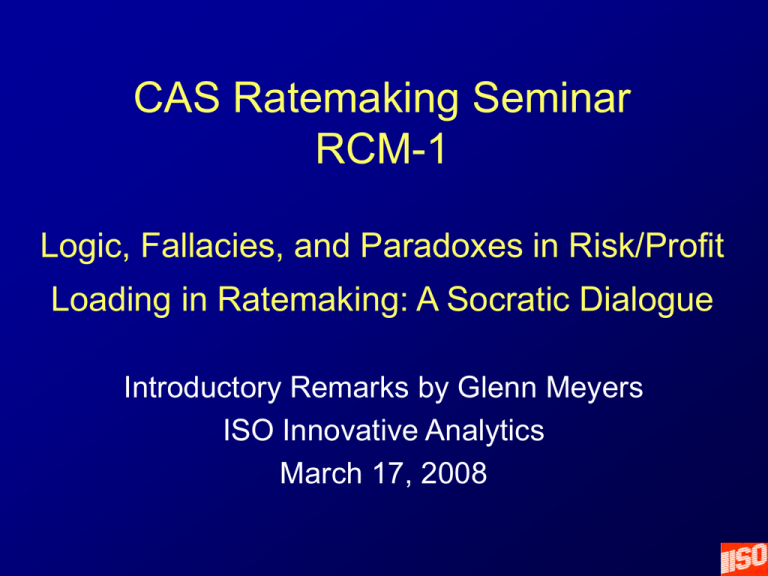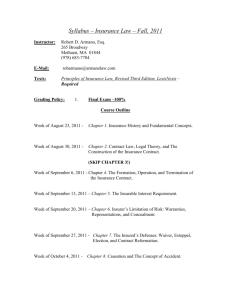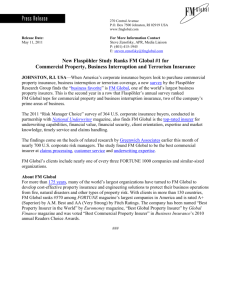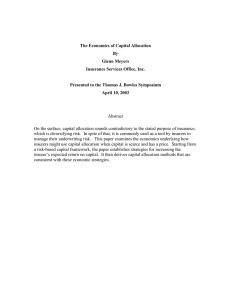CAS Ratemaking Seminar RCM-1 Logic, Fallacies, and Paradoxes in Risk/Profit
advertisement

CAS Ratemaking Seminar RCM-1 Logic, Fallacies, and Paradoxes in Risk/Profit Loading in Ratemaking: A Socratic Dialogue Introductory Remarks by Glenn Meyers ISO Innovative Analytics March 17, 2008 Insurer Risk and Capital Management Perspective • Risk based capital – The insurer's risk, as measured by its stochastic distribution of outcomes, provides a meaningful yardstick that can be used to set capital requirements. • Insurer risk management – The insurer manages its business to get the best return on its cost of capital. Steps for Insurer Capital Management in Ratemaking • • • • Determine total capital for insurer Determine rate of return on that capital Allocate capital to business segment Calculate cost of business segment holding that allocated capital – My remarks today address this part of the problem. Insurer Risk Management • Reserve Risk contributes to the need for capital and hence it contributes to the ($) cost of capital. • How long you need to hold capital is a consideration in determining an acceptable price. The Cash Flow for Underwriting Insurance • Investors provide capital – Through the insurer they: • Receive premium income • Pay losses and other expenses • Receive investment income – Invested at interest rate i% • Release capital as liabilities become certain. Net out the loss and expense payments • Investors provide capital – Through the insurer they: • Receive profit provision in the premium • Receive investment income from capital as it is being held. • Release capital as liabilities become certain. • We want the present value of the income to be equal to the capital invested at the rate of return for equivalent risk Define Terms • Allocated Capital invested in year t • Provision for Profit • Insurer’s return on invested assets • Insurer’s target return on capital Ct P i r Calculating the Profit Provision Time 0 Capital Allocated at time t C0 Amount Released at time t 0 1 C1 Rel1 = C0 (1+i) – C1 --- --- --- t Ct Relt = Ct-1 (1+i) – Ct --- --- -- Then P C0 t 1 Rel t 1 r t Calculating the Profit Provision Another Formula P C0 Ct 1 1 i Ct 1 r C0 1 r 1 i C1 1 r 1 i C2 1 r 1 i ... 2 3 1 r 1 r 1 r t t 1 r i t 0 Ct 1 r t 1 Sample Calculation t 0 1 2 3 4 5 6 7 8 Disc Ct TVaR LDisc t t 60,502 72,015 11,512 36,519 46,990 10,471 19,540 27,430 7,890 9,138 14,756 5,618 3,616 7,379 3,762 1,141 3,502 2,361 256 1,632 1,376 32 869 838 1 99 98 Profit = 1,348 = 2.2% of Initial Liability Prediction This how actuaries will include the cost of capital in future insurance costing. Main Obstacles to Overcome • Fuzzy relationship between risk and capital – Insurers are starting to build internal capital models – Examples EU Solvency II, British FSA, S&P • Quantification of all risks – – – – Underwriting risk and reserving risk Asset risk - Several commercial models Operational risk Other • Consensus – Will not come until above issues are substantially settled.






